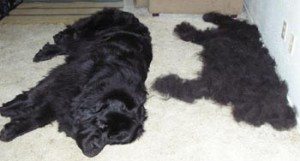Q: I adopted a 3 year old lab-shepherd mix a few months ago. Up until a month ago, she didn’t shed at all. But then for the last month she is dropping fur like there’s no tomorrow! Lots and LOTS of fur! I know that coats change seasonally, but how long should the shed last? She doesn’t seem to be slowing down and the fact that she changed from not shedding to dropping tons of fur very suddenly has me worried. Should I be concerned?
Thanks,
Kathy
A:Dog shedding can be frustrating no matter how much we love our dogs. All animals will shed on a regular basis. This is part of the natural life cycle of hair shafts within the follicles. Each hair grows from a simple opening within the skin called a hair follicle. Each hair shaft produced by a hair follicle will eventually die and be removed (shed) and replaced by a new hair shaft produced by that hair follicle. All hair shafts go through

phases of growth and shedding. However, the phases which affect the rate of hair growth and will vary by breed, age, hormones, environment and the overall health of your dog. These factors also contribute to the length and texture of the hair, though genetics is the predominant factor.
Dogs with continuously growing hair, like Poodles or Yorkshire Terriers for example, have hair shafts with longer life spans and therefore shed very little. On the other hand, dogs like Labradors and Huskies, have a shorter hair shaft life span and more abundant undercoats, resulting in greater shedding.
In general, most dogs will shed extra during Spring and Fall. Dogs are double-coated, meaning they have undercoats. These are secondary hairs that occur around the primary hairs and tend to be shorter and softer. Seasonal shedding occurs as a result of temperature change. This process is often called “blowing coat.” When the weather warms, dogs shed their old winter undercoats to make way for a lighter summer coat. Then, when it begins to get cool again, dogs shed their lighter undercoats and grow a thicker, warmer coat for winter. Not all coat types are affected the same way by temperature changes. For example, dogs like Bichons and Shih Tzus have very little undercoat and therefore shed less when seasons change. However, dogs like Malamutes have heavy, thick undercoats that make shedding much more obvious.
No matter what the breed or mix of dog, shedding is normal, but chronic hair loss, which shows a patchy or bald coat, is almost always caused by an underlying factor. Skin infections (bacterial, fungal, parasitic), allergies, endocrine diseases, nutritional or vitamin deficiencies, can cause hair loss or change the rate of hair growth.
Best of luck,
Editor’s Note: If your pet is a big shedder, you might want to check out our Product Review of the Furminator brush!
 Montreal Dog Blog Montreal's Online Dog Park
Montreal Dog Blog Montreal's Online Dog Park




